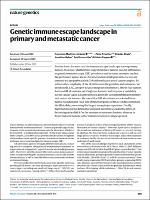Genetic immune escape landscape in primary and metastatic cancer

Author
Date
2023-05Permanent link
https://hdl.handle.net/11351/9954DOI
10.1038/s41588-023-01367-1
ISSN
1546-1718
PMID
37165135
Abstract
Studies have characterized the immune escape landscape across primary tumors. However, whether late-stage metastatic tumors present differences in genetic immune escape (GIE) prevalence and dynamics remains unclear. We performed a pan-cancer characterization of GIE prevalence across six immune escape pathways in 6,319 uniformly processed tumor samples. To address the complexity of the HLA-I locus in the germline and in tumors, we developed LILAC, an open-source integrative framework. One in four tumors harbors GIE alterations, with high mechanistic and frequency variability across cancer types. GIE prevalence is generally consistent between primary and metastatic tumors. We reveal that GIE alterations are selected for in tumor evolution and focal loss of heterozygosity of HLA-I tends to eliminate the HLA allele, presenting the largest neoepitope repertoire. Finally, high mutational burden tumors showed a tendency toward focal loss of heterozygosity of HLA-I as the immune evasion mechanism, whereas, in hypermutated tumors, other immune evasion strategies prevail.
Keywords
Genome; Tumour immunologyBibliographic citation
Martínez-Jiménez F, Priestley P, Shale C, Baber J, Rozemuller E, Cuppen E. Genetic immune escape landscape in primary and metastatic cancer. Nat Genet. 2023 May;55:820–31.
Audience
Professionals
This item appears in following collections
- VHIO - Articles científics [1250]
The following license files are associated with this item:

 Private area
Private area Contact Us
Contact Us







